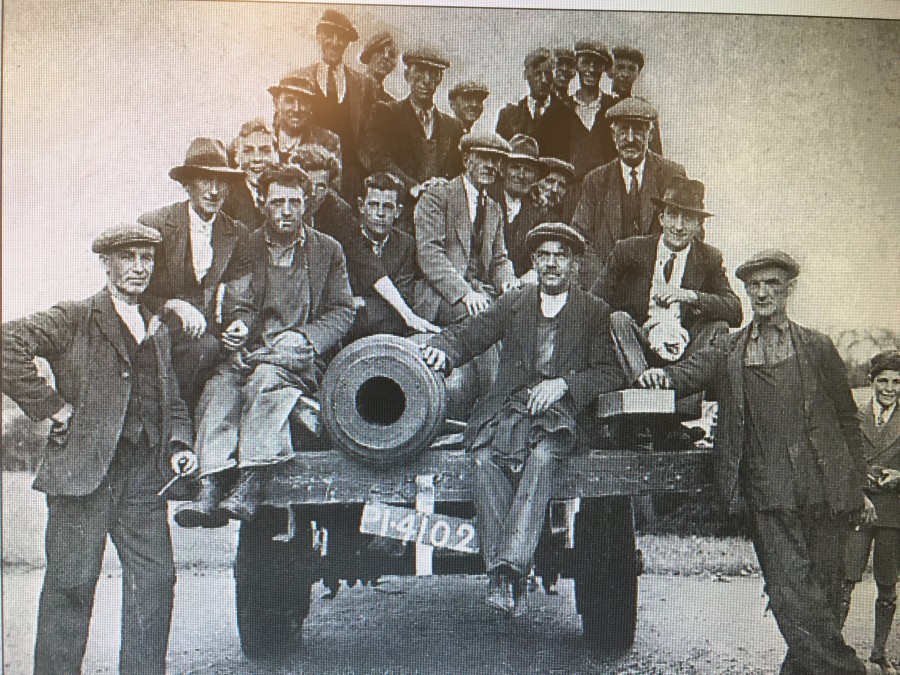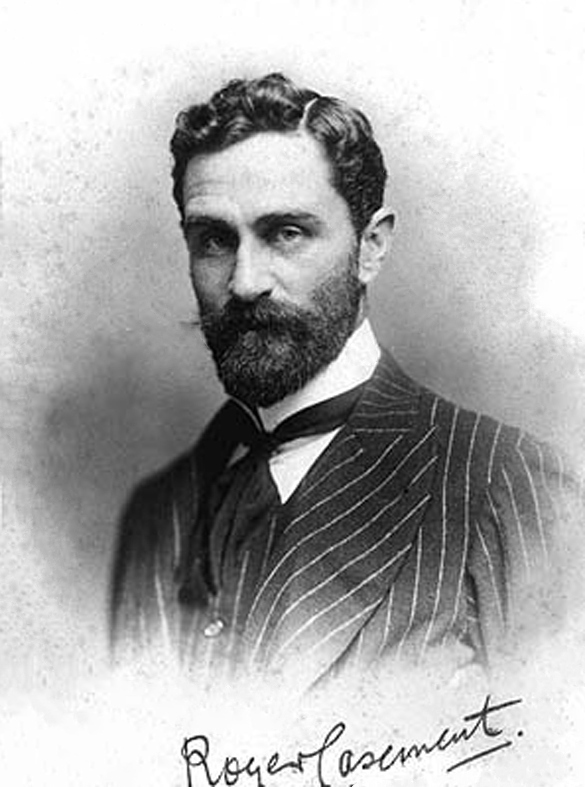
Kieran’s Our City, Our Town,
Cork Independent, 30 June 2016
Remembering 1916, The Verdict for Roger Casement
Continuing to explore the conversations in Cork post Easter 1916, this day, 100 years ago, the trial of Dublin born Sir Roger Casement (1864-1916), ended its process of interrogation. Between the afternoon of 20 April and the afternoon of 21 April 1916 he attempted to land 20,000 guns and ammunition at Banna Strand, County Kerry through a vessel called SS Libau but adapting the name of a real neutral merchant Norwegian ship called the SS Aud. The ship on being escorted into Cork Harbour by the British Navy was scuttled by its German Naval Officer Captain Karl Spindler.
On 30 June 1916 Sir Roger Casement was found guilty of high treason and sentenced to death (on 3 August) in Pentonville Prison. The newspapers of the day including the Cork Examiner all wrote about the tense silence when each of the three judges finished their questioning. It was nearly three o’clock in the afternoon when the jury retired. In a few moments they sent out for the ‘original’ code, and for a copy of the indictment. These were supplied to them, but the Lord Chief Justice refused to send them a copy of the evidence, which they also asked for. At this time the court was crowded, barristers in wig and gown standing all over the floor of the court, the public, including many ladies in the smartest of summer dress, being packed in the galleries. Casement had disappeared from the dock. Then followed the long wait of close upon an hour whilst the judges had left the bench.
At ten minutes to four the judges returned. The jury soon followed, and Roger Casement again entered the dock. Here was a man who had spent 20 years in sub-Saharan Africa, including over a decade working for the British Foreign Office and was a consular official in Brazil for seven years. The names of the jury having been called over, they were asked if they were agreed upon a verdict. The foreman said they found the prisoner guilty. Casement was asked by the Crown if he has anything to say why sentence of death should not pass upon him according to law. All eyes were on the prisoner, but he remained perfectly clam, and read a long statement, which he had prepared twenty days previously – the main gist of which was that he objected to the jurisdiction of the court. He was then sentenced to death by hanging.
Sir Roger Casement was in the British Consular service for 18 years, and was appointed British Commissioner to investigate the methods of the rubber collection and treatment of the primitive Indian tribes in the region known as Putumayo, on the Upper Amazon, a region dominated by the Peruvian Amazon Company. The publication of his report in July, 1912, which revealed the systemic perpetration of appalling atrocities committed by the Peruvian agents of the company occasioned profound indignation throughout the civilised world. He relinquished the Consul-Generalship at Rio de Janeiro in 1913.
The O’Brien Press 16 Lives series (2016) commemorates the 16 men executed after the Easter Rising. The author Angus Mitchell of 16 Lives, Roger Casement outlines that Casement took an active part in the Home Rule controversy in Ireland on behalf of the Nationalist cause. He became a member of the Gaelic League in 1904. He was a skilled and determined networker in the lead-up to the Easter Rising, counting committed republicans Alice Milligan and Bulmer Hobson as close friends. His acquaintance with the historian Alice Stopford Green introduced him to the medieval scholar Eoin McNeil, the German Philologist Kuno Meyer, and a busy circle of nationalist intellectuals in London. He regularly visited the house Gaelic League Organisers, Robert and Sylvia Lynd, in Hampstead.
As the Home Rule crisis escalated, Casement resigned from the Foreign Office and he devoted his energies openly to Irish independence. After the founding of the Irish Volunteers in 1913, Casement spoke at recruitment rallies across the country and accompanied Pádraig Pearse, Tomás MacDonagh and Eoin MacNeill in building up the movement. In late July 1914, by then in the US, he heard about the successful landing at Howth by Erskine Childers and Mary Spring-Rice. His significant role in the planning of this venture gave him access to the inner circle of Clan na Gael, and in November 1914, with the support of the IRB executive, he arrived in Berlin to promote and explain the Irish struggle, both politically and intellectually. His efforts to recruit and train an Irish Brigade, from among the Irish born British army prisoners of war in Germany, failed. In April 1916, returning to Ireland, Casement was captured at an old Ringfort near Banna Strand and stood trial for high treason.
On 3 August 1916, Casement was hanged in Pentonville Prison. His body was returned to Ireland in 1965 and despite his wishes to be buried in his ancestral home in Antrim, he was buried in Glasnevin, Dublin. As for the Aud, it now lies in 36 metres of water in Cork Harbour and is very broken up. There are a number of boilers to be seen as well as well as thousands of bullets strewn on the sea floor. Two of its fully restored anchors are now located at Tralee’s Brandon Conference Centre.
Captions:
850a. Roger Casement, 1864-1916 (source: Cork City Library)
850b. Photograph of The Aud, c.1916 (source: Cork City Museum)

Question to the CE:
To ask the CE for an update on Tramore Valley Park and opening and the Marina Park (Cllr Kieran McCarthy)
Motions:
That the City Council liase with Fáilte Ireland with regard to maximising Cork’s presence on the new Ireland’s Ancient East website (Cllr Kieran McCarthy)
That the Council under the healthy cities programme develop a community garden in Mahon, perhaps on the grounds of Ringmahon House (Cllr Kieran McCarthy)
On Saturday, 25 June 2016, 12noon, Cllr Kieran McCarthy, in association with the Friends of St Finbarr’s Hospital, will give a public historical walking tour of the hospital grounds (meet at gate). The walk is free and takes place to support the summer bazaar of the Friends. Cllr McCarthy noted: “St Finbarr’s Hospital, the city’s former nineteenth century workhouse, serves as a vast repository of narratives, memories, symbolism, iconography and cultural debate, this year the site is 175 years old”. When the Irish Poor Relief Act was passed on 31 July 1838, the assistant Poor Law commissioner, William J Voules came to Cork in September 1838 to implement the new laws. Meetings were held in towns throughout the country. By 1845, 123 workhouses had been built, formed into a series of districts or Poor Law Unions, each Poor Law Union containing at least one workhouse. The cost of poor relief was met by the payment of rates by owners of land and property in that district.
In 1841 over eight acres, were leased to the Poor Law Guardians from Daniel B. Foley, Evergreen House, Cork. Mr. Foley retained an acre, on which was Evergreen House with its surrounding gardens, which fronted South Douglas Road (now a vacant concrete space). The subsequent workhouse that was built on the leased lands was opened in December 1841. It was an isolated place, built beyond the City’s toll house and toll gates. The Douglas Road workhouse was also one of the first of over 130 workhouses to be designed by the Poor Law Commissioners’ architect George Wilkinson.
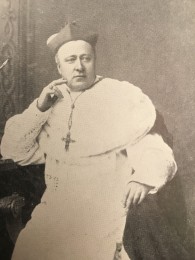
Kieran’s Our City, Our Town Article,
Cork Independent, 23 June 2016
Remembering 1916, Death of a Bishop
In continuing to present a broad profile of life in Cork in 1916, this week one hundred years ago, the city and region lamented the death of the Bishop of Cork Thomas Alphonsus O’Callaghan (1839-1916). He passed away on 14 June and the newspapers for days after were filled with information spreads of his life, work and funeral. His role in supressing the 1916 rising contribution in Cork was limited as he was ill at the time and he sent his Assistant Bishop Cohalan to the Volunteer Hall on Sheares Street. However he is still a gentleman worth recalling. He set up the industrial school model and also funded some very beautiful churches in the late nineteenth and early twentieth centuries.
Born in the South Parish, Cork, in 1839, at the age of eighteen years, Bishop Thomas O’Callaghan entered the Novitiate of the Dominicans at Tallaght, and elevated to the priesthood in 1864. He spent six years after that teaching in the convent at Tallaght, and then returned to Cork. Before his appointment as Prior of San Clemente he was in the house of the Order at Claddagh, Galway, and St Catherine’s, Newry He returned to his native city to the exalted office of Co-adjutor-Bishop to Bishop William Delaney in 1884.
Both Bishops Delaney and O’Callaghan were advocates of educational reform. They determined that Cork would be the location of a model industrial school run by a Catholic order, and they saw it as an important step in overcoming the years of discrimination against Catholics by the governments of those years. It was this ambition that drove them to turn the newly founded St Patrick’s Orphanage into an industrial school in Greenmount. They saw the industrial school system as one that would benefit the children who were being raised in poverty in the Cork area. Because of this drive, the orphanage acquired the status of Industrial School on 14 March 1871. The recent Commission to Inquire into Child Abuse has much to say on the history of the industrial school model and the good and bad of the Greenmount site can be viewed on their report, which can be accessed on their website.
Bishop of Cork Delaney and his successor Bishop O’Callaghan pursued a vast building programme replacing the older stock of churches of the diocese with new iconic edifices for veneration. Architect Samuel Hynes completed much work for the Diocese of Cork and further afield. He was involved in the design of eight churches over a sixteen-year period. The eight churches, somewhat similar in design, created a forum for engaging with the Catholic Church. New schools were also provided in several parishes. Work progressed so well that the diocese became dotted with religious and educational establishments all of which were undertaken at a time of great poverty and hardship. From the Dictionary of Irish Architects at the Irish Architectural Archive one can piece together the church works – new foyer, St Vincent ‘s Church, Sunday’s Well, Cork (1884-85), new church, Glanmire, Co Cork (1893), new church, Blarney, Co Cork (1893-94), two new side altars, St Mary’s Dominican Church, Pope’s Quay, Cork (1895), new church, St Nicholas Church, Blackpool, Cork (1895), new church, St Joseph’s Church, Wilton Road, Cork (1895-97), new parochial house, Caheragh, Dunmanway, Co Cork (1896), new church, Lisgriffin Church, Buttevant, Co Cork (1896-97), church rebuilding, Castletownroche Church, Co Cork (1897), St Joseph’s Oratory, South Charitable Infirmary & County Hospital, Cork (1899), New oratory, Gougane Barra, Co Cork (1901), new choir stalls, pulpit and Bishop’s throne, Cathedral of SS Mary and Anne’s (1901) and additions, St Patrick’s Church, Fermoy, Co Cork (1901).
Samuel Hynes’ convent work included: a new chapel and campanile, Convent of Mercy, Bantry, Co Cork (1877-78), new wing, Convent of St Marie Reparatrice, Summerhill South, Cork (1892), and additions at the Presentation Convent, Mallow (1900). For the pastoral care of young people, a new Diocesan College of St Finbarre, Farranferris, Co Cork was constructed between 1883-85, a new Sisters of Mercy Orphanage, Cobh, Co Cork (1889), a new building, Mount St Joseph, Presentation Brothers Novitiate, Cork (1892), a new Catholic Boy’s Industrial School, Greenmount, Cork (1900) and a new college for the Christian Brother’s, St Patrick’s Place, Cork (1901-02).
Another key event pursued under Bishop Delaney and subsequently by Bishop O’Callaghan occurred when the pilgrimage island of Gougane Barra was leased on 29 January 1873 for 999 years at a nominal rent of one shilling from Protestant landlord Richard Mellifont Townsend, to Bishop Delaney and Parish Priest of Inchigeela, Fr Jeremiah Holland. Townsend reserved exclusive rights of fishing around the island. The Register of Landowners in County Cork 1876 shows that Richard Townsend’s estate totalled 5,977 acres in and around Dunbeacon in Bantry and extended eastwards to Clontaff, a townland near Skibbereen. The giving of such an important site by a Protestant landlord to a Catholic Bishop cannot be understated. In the midst of large Protestant holdings in West Cork creating their own unique cultural geography of inclusion and exclusion. The island was afterwards assigned to Bishop O’Callaghan, Dean Neville and Fr Patrick Hurley, who developed the site further as a key pilgrimage site in the south of Ireland.
Tour notice: Historical walking tour of former workhouse, St Finbarr’s Hospital, Douglas Road with Kieran, 25 June, 12noon, free, meet at gate, in association with Friends of St Finbarr’s Garden Fete.
Captions:
849a. Bishop Thomas Alphonsus O’Callaghan, 1839-1916 (source: Cork City Library)
849b. Samuel Hynes, principal architect for the Diocese of Cork and Ross in the late nineteenth and early twentieth centuries (source: Cork City Library)
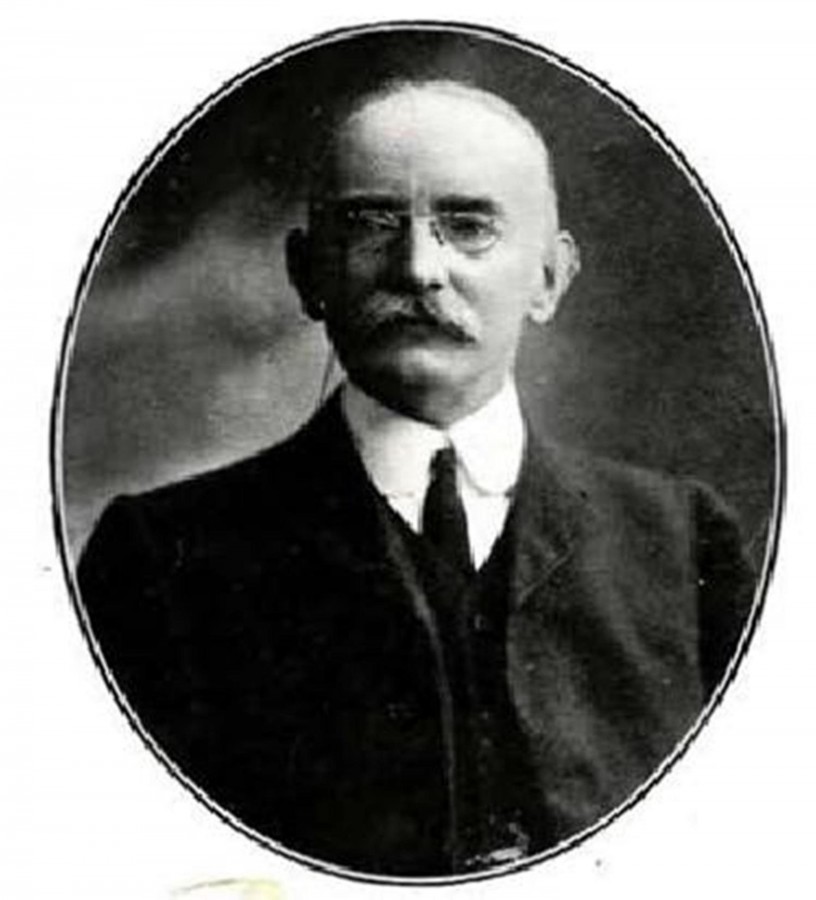
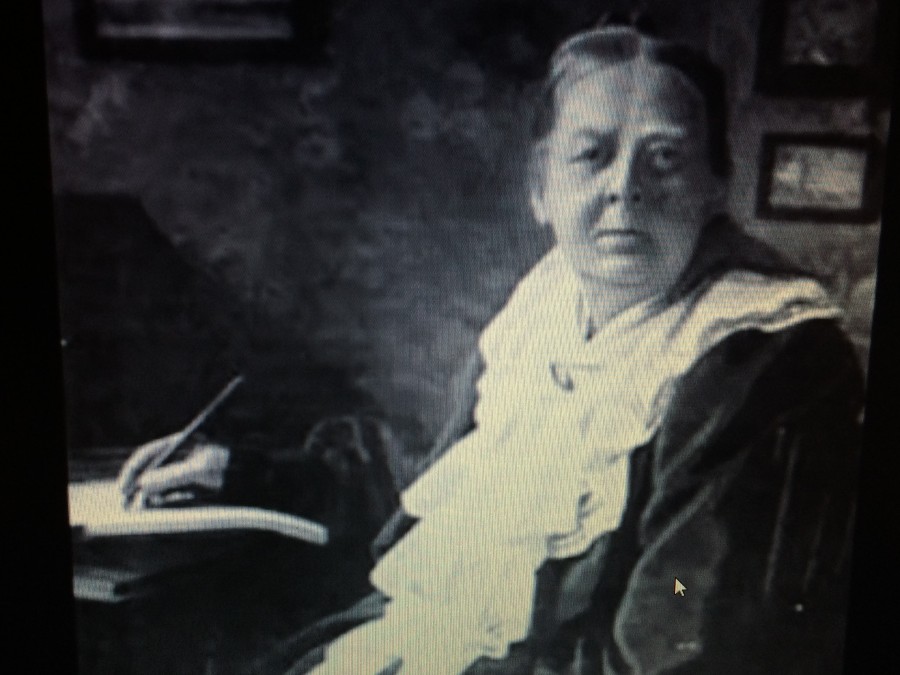
Kieran’s Our City, Our Town Article,
Cork Independent, 16 June 2016
Remembering 1916, The Legacy of Mary Everest
This day one hundred years ago on 16 June 1916, Cork lamented the death of Mrs George Boole – Mary Everest – who died in London (that week) at the age of 84. The story appeared in a small column within the Cork Examiner, which described the removal of “another link in the chain connecting the present of University College Cork with the past of the old Queen’s College”. One of the most illustrious names associated with the college since its foundation was that of George Boole, who for a number of years occupied a Professorial Chair in Maths. Some of his greatest publications were written whilst he held that Chair. The bi-centenary of his birth was well and rightly celebrated last year in UCC. The newly unveiled sculpture of Boole is also great to view outside the Boole Library. It is carved by Irish sculptor Paul Ferriter and engraved by Ken and Matthew Thompson.
George Boole’s widow, was likewise a talented writer and psychologist. Mary Everest Boole (1932-1916) was born in Gloucestershire where her father was a minister. She spent her early years in Poissy, France where she had a private tutor. On moving back to England at age eleven she assisted her father with his work and was largely self-taught. She was introduced to George Boole through an uncle – Colonel Sir George Everest (1790-1866) who was a Welsh surveyor and geographer, and the Surveyor General of India from 1830 through 1843.
George Everest was chiefly responsible for completing the section of the Great Trigonometric Survey of India along the meridian arc from southern India extending north to Nepal, a distance of about 2,400 kilometres (1,500 miles). This survey was started by William Lambton in 1806 and it lasted for several decades. In 1865, Mount Everest was named in his honour in the English language despite his objections by the Royal Geographical Society.
On the introduction by George Everest to George Boole of his niece Mary, Boole began to tutor her in mathematics. They married and moved to Cork where George was appointed Professor of Mathematics at Queen’s College (now UCC). During nine years of marriage they had five children and then George died of pneumonia. After her husband’s death Mary moved back to England. She first worked as a librarian at Queen’s College, Harley Street in London and became an unofficial tutor to the students. From the age of fifty, Mary started writing books and articles including Logic Taught by Love in 1889, The Preparation of the Child for Science in 1904 and in 1909, Philosophy and Fun of Algebra. Her collected writings were published in 1931 and run to four volumes. Mary Boole regarded herself as an educational psychologist. She was interested in understanding how children learn mathematics and science using the reasoning part of their mind, their physical bodies and their “unconscious processes”. She advocated the use of the reflective journal and cooperative learning where students could share their ideas with one another in an environment of peer tutoring.
The Cork Examiner article makes reference to Mary’s daughters – “it is a remarkable fact that her genius has descended to her daughters, who, by the way, were all born in Cork. It is noteworthy that the late Professor Boole’s grandson has obtained the two highest prizes in mathematics at Cambridge University, and has recently been made Professor of Meteorology by the Government”. Her five daughters made their mark in a range of fields. Alicia (1860–1940) became an expert in four-dimensional geometry. Lucy (1862–1904) was a chemist and pharmacist and the first female professor at the London School of Medicine for Women in the Royal Free Hospital. She was the first female Fellow of the Royal Institute of Chemistry. Mary Ellen (b.1856) married mathematician Charles Hinton. Hinton was a British mathematician and writer of science fiction works titled Scientific Romances. He was interested in higher dimensions, particularly the fourth dimension. Margaret (1858–1935) was the mother of mathematician Geoffrey Ingram Taylor, who is referenced in the newspaper quote. George (1886 –1975) was a British physicist and mathematician, and a major figure in fluid dynamics and wave theory. In 1910 he was elected to a Fellowship at Trinity College, and the following year he was appointed to a meteorology post, becoming Reader in Dynamical Meteorology.
Ethel Lilian (1864–1960) married the Polish revolutionary Wilfrid Michael Voynich and was the author of a number of works. She is most famous for her first novel The Gadfly, first published in 1897 in the United States (June) and Britain (September), about the struggles of an international revolutionary in Italy. This novel was very popular in the Soviet Union and was the top bestseller and compulsory reading there, and was seen as ideologically useful; for similar reasons, the novel has been popular in the People’s Republic of China as well. By the time of Voynich’s death The Gadfly had sold an estimated 2,500,000 copies in the Soviet Union and had been made into two Russian movies, first in 1928 in Soviet Georgia (Krazana) and then again in 1955.
Captions:
848a. Mary Everest, 1932-1916 (source: University College Cork).
848b. Ethel Lilian Voynich, 1864 –1960, née Boole (source: University College Cork).
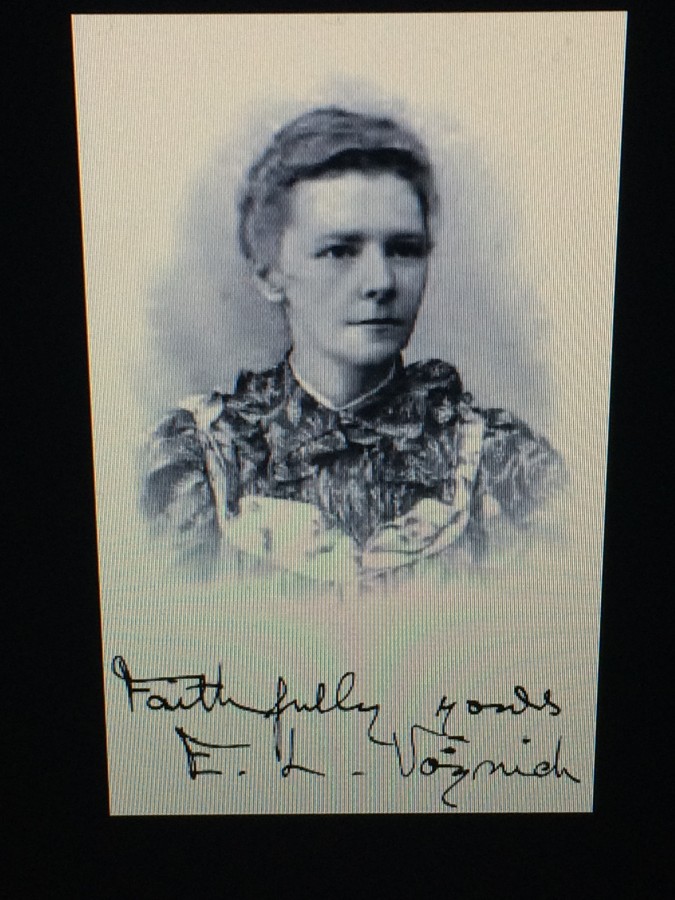
On Saturday, 25 June 2016, 12noon, Cllr Kieran McCarthy, in association with the Friends of St Finbarr’s Hospital, will give a public historical walking tour of the hospital grounds (meet at gate). The walk is free and takes place to support the summer bazaar of the Friends. Cllr McCarthy noted: “St Finbarr’s Hospital, the city’s former nineteenth century workhouse, serves as a vast repository of narratives, memories, symbolism, iconography and cultural debate, this year the site is 175 years old”. When the Irish Poor Relief Act was passed on 31 July 1838, the assistant Poor Law commissioner, William J Voules came to Cork in September 1838 to implement the new laws. Meetings were held in towns throughout the country. By 1845, 123 workhouses had been built, formed into a series of districts or Poor Law Unions, each Poor Law Union containing at least one workhouse. The cost of poor relief was met by the payment of rates by owners of land and property in that district.
In 1841 over eight acres, were leased to the Poor Law Guardians from Daniel B. Foley, Evergreen House, Cork. Mr. Foley retained an acre, on which was Evergreen House with its surrounding gardens, which fronted South Douglas Road (now a vacant concrete space). The subsequent workhouse that was built on the leased lands was opened in December 1841. It was an isolated place, built beyond the City’s toll house and toll gates. The Douglas Road workhouse was also one of the first of over 130 workhouses to be designed by the Poor Law Commissioners’ architect George Wilkinson.
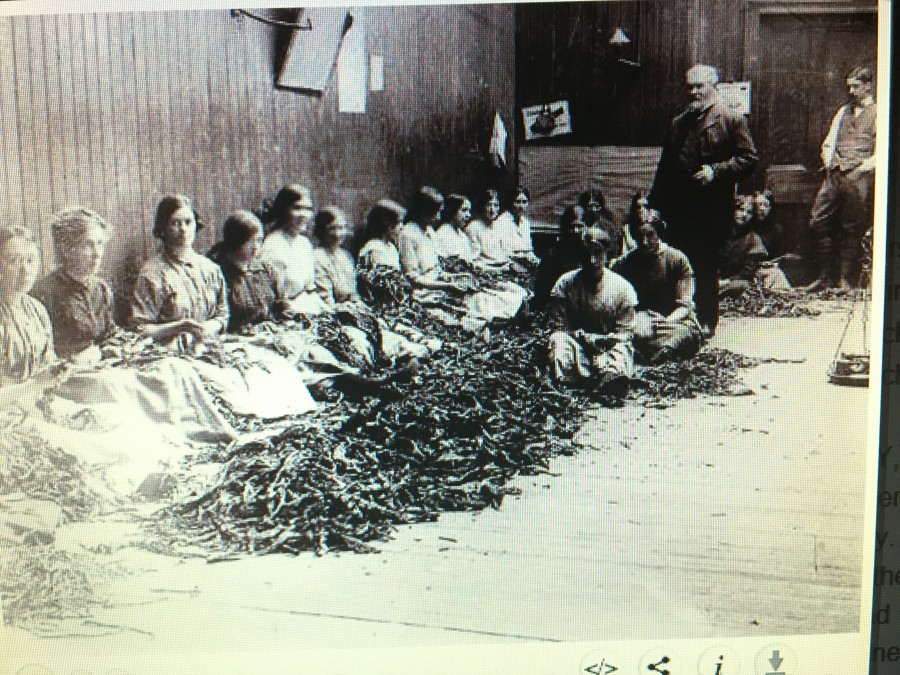
Kieran’s Our City, Our Town,
Cork Independent, 9 June 2016
Remembering 1916, Life at the Front
For early June 1916, the diversity of news stories is very interesting to read in local newspapers such as the Cork Examiner. One hundred years ago exactly amidst the backdrop of military curfews and Frongoch deportations, the references to those Corkmen fighting on the western front was significant, primed with propaganda but also touching.
On 29 May 1916 the management of Cork Opera House began a week long “instructive entertainment programme” in a series of cinema war records. Photos of a number of celebrities identified with the Allies cause, were popular. These were followed by several clever cartoons illustrating the “artist’s conception of things”, and the pointed humour of some of these were created to evoke applause. Scenes on the streets of Johannesburg, South Africa, were displayed as well as British and French battleships in action off the Turkish coast. Smaller craft were shown doing scouting duty. A French airman was also shown decorated on board a battleship for his daring feats. Somewhere in France or Flanders was the next scene of operations. Neuve Chapelle and other villagers were presented after the German bombardment. The desolation of the landscape was pictured – nothing but ruins stood where once churches, schools, public buildings, or industrial establishments flourished. The commentary on the war then led to images of graveyards, where lay hundreds and hundreds of dead soldiers. From ruined villages one was taken to the British trenches, where all the phases of modern warfare were vividly photographed. A battery of 18-pounders was shown in action against a German blockhouse, which was blown to bits.
Trench life was highlighted – the Grenadier Guards marching past to the firing line as well as a Welsh battalion. The greatest interest focused on the Irish regiments. The Royal Irish, the Munsters, and the Connaughts were shown going to Roman Catholic Mass at the front, and then marching off into action. Captain William Redmond MP (for Tyrone East) of the Irish Guards was recognised leading his company to the trenches, and he received audience applause. The work of the Royal Army Medical Corps (RAMC) was detailed. On mobilization the Corps consisted of approximately 9,000 other ranks, by 1918 there were 13,000 RAMC Officers and 154,000 other ranks. Words of praise were given to the camera operators/ producers for having secured fine pictures under exceptionally unfavourable circumstances of difficulty and danger. Some of the pictures were taken within 150 yards of the enemy’s front trenches. The war pictures were to be shown twice nightly at Cork Opera House during the first week of June 1916. There was be a matinee on the Saturday at 2.30 pm.
On the 1 June 1916 further preparatory work began on the establishment of the Government Munitions Factory in Cork. Provision was to be made for the accommodation of those tenants of St Peter’s Market who were to be dislocated. There were to be in all some 78 tenants to be provided for by Cork Corporation. As the accommodation available in the northern avenue of the Bazaar Market only measures 133 feet by 42 feet, with a wing 40 feet by 20 feet, about seventeen tenants, who would otherwise be without room, would have to be accommodated in a new annexe, which was to be built in Portney’s Lane, adjoining, on the site of some old houses recently demolished. An amount of work had to be done, and this included not only the draining of the northern avenue of the Bazaar Market but also the concreting of a large portion of the floor. It was expected that some time would elapse before St Peter’s Market could be handed over to the Government authorities.
In early June 1916, there was much anxiety by the relatives of Corkmen serving in the various units of the British Navy understood to be on duty in the North Sea area. There were many inquiries as to the arrival of casualty lists. It was announced that the three destroyers – Nomad, Nestor and Shark – had been sunk. In and around Kinsale, from which district alone several hundred were serving in the Royal Navy, a considerable proportion of them were in the Grand Fleet. Crosshaven, Ringaskiddy and Aghada were also represented. The full official casualty lists required some days to complete.
On 2 June, the Cork Examiner related the contribution of Lambkins Tobacco and the story of the “boys in the trenches” needing a smoke. Lambkin’s of Cork figured high up on the list of reputable brands. The company had just received a third order for 20,000lbs of tobacco for 320,000 men – so that each would receive an ounce of tobacco. The mixture was made up of two of the best American leaves and a special growth, the result being a smoke that is full flavoured and cool. The making up, packing etc, was mostly carried out in the factory, and it gave a good deal of employment, as well as a huge financial boast to the Cork box industry. Lambkins Factory was based in Fishers Street Merchant’s Quay, Cork. It was observed that the ladies often packed a love message in the tins, which were for dispatch to front line troops.
To be continued…
Captions:
847a. Photograph of staff of Lambkins Snuff and Tobacco Factory (source: Cork City Library)
847b. Captain William Redmond, Irish Guards, c.1916 (source: RTE Archives)
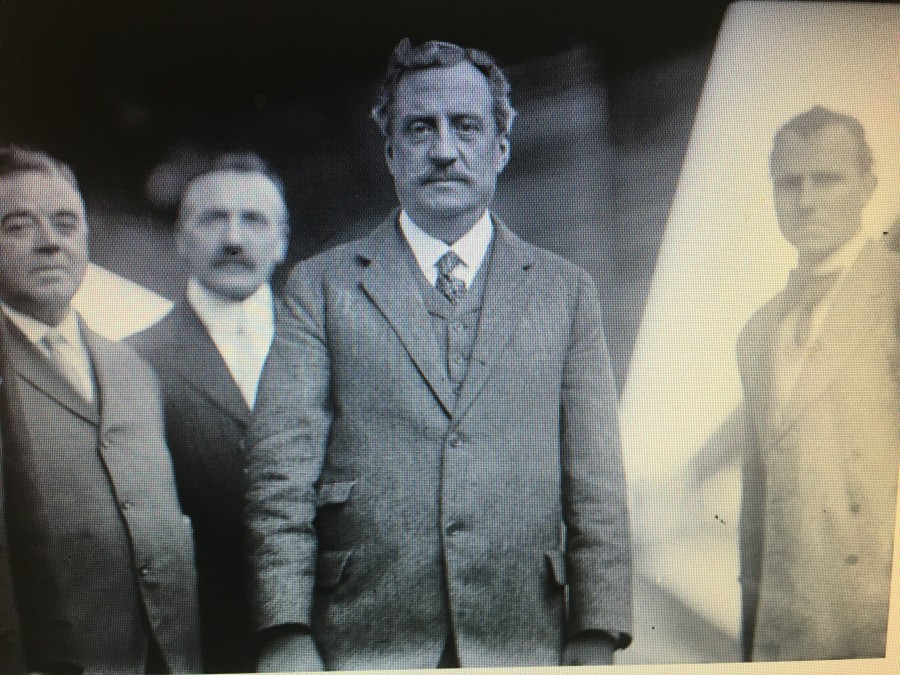
Cllr Kieran McCarthy invites all Cork young people to participate in the seventh year of McCarthy’s ‘Make a Model Boat Project’. All interested must make a model boat at home from recycled materials and bring it along for judging to Cork’s Atlantic Pond on Sunday 12 June 2016, 2pm. The event is being run in association with Meitheal Mara and the Cork Harbour Festival. There are three categories, two for primary and one for secondary students. The theme is ‘Cork Harbour Boats’, which is open to interpretation. There are prizes for best models and the event is free to enter. Cllr McCarthy, who is heading up the event, noted “I am encouraging creation, innovation and imagination amongst our young people, which are important traits for all of us to develop”. In addition, Cllr McCarthy emphasises that places like the Atlantic Pond are an important part of Cork’s natural and amenity heritage. For further information and to take part, please sign up at www.corkharbourfestival.com.
The Cork Harbour Festival will bring together the City, County and Harbour agencies and authorities. It connects our city and coastal communities. Combining the Ocean to City Race and Cork Harbour Open Day, there are over 50 different events in the festival for people to enjoy – both on land and on water. The festival begins the June Bank Holiday Saturday, 4th June, with the 28km flagship race Ocean to City – An Rás Mór. Join thousands of other visitors and watch the hundreds of participants race from Crosshaven to Douglas to Cork City in a spectacular flotilla. Cllr McCarthy noted: “During the festival week embark on a journey to discover the beautiful Cork Harbour and enjoy free harbour tours, sailing tasters, open days at Spike Island and Fort Camden, and lots more; we need to link the city and the harbour more through branding and tourism. The geography and history of the second largest natural harbour in the world creates an enormous treasure trove, which we need to harness, celebrate and mind”.
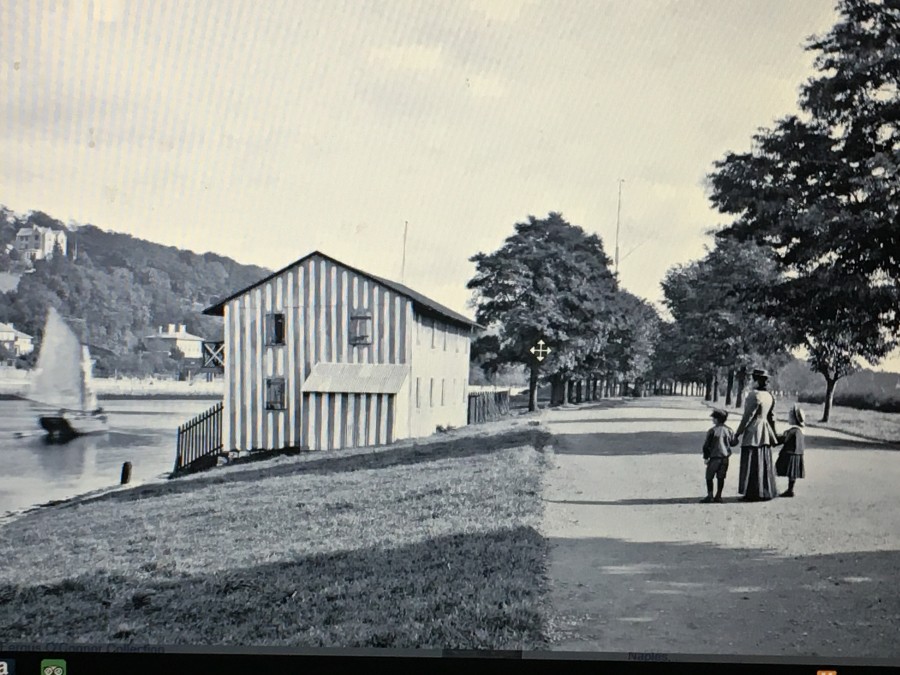
Kieran’s Our City, Our Town Article,
Cork Independent, 2 June 2016
Remembering 1916, Matters of Time
The matter of time was an issue for the citizens of Cork in early summer 1916. Starting on 30 April Germany and its World War I ally Austria-Hungary were the first to use a Daylight Saving Scheme as a way to conserve coal during wartime. Britain, most of its allies, and many European neutrals soon followed suit to provide more time for agricultural activities in the evenings. Russia and a few other countries waited until the subsequent year and the United States of America implemented it in 1918.
Irish society operated on 25 minutes and 22 seconds behind Greenwich Mean Time. On 20 May 1916, Cork citizens woke up to find the new British Daylight Saving Scheme in full operation. All official clocks, at post offices and elsewhere were duly put forward as required by the new Act. All other clocks showing time to the public on the streets of Cork were similarly advanced during the night.
Irish newspapers such as the Cork Examiner and Irish Times detailed in editorials on 21 May that some of the trains were delayed. While the railway officials did their best to start trains according to the time table, they chose not to leave behind passengers who were seen rushing into the station at the last moment. These little delays, when accumulated over a line of ten or twelve stations, added up to something considerable when the train arrived at its destination.
In the city churches, Roman Catholic masses were celebrated according to the official time. An exception was, however, made at St Finbarr’s West at the Lough, on account of the number of country residents belonging to the parish, some of whom might have missed Mass if the new time was adopted. The following Sunday the masses were celebrated according to the official clock time. The licensed trade was affected by having to close an hour earlier in the evening than usual, but as against this, opened an hour earlier.
As the summer passed, the end of September 1916 meant that Great Britain had to revert to the normal time. Ireland decided, however, not to revert to the ‘old time’, but to try another change – that of adopting Greenwich Mean Time. The legislation to change this was argued for by principally the Irish port authorities and Chambers of Commerce and Shipping. It meant that for the immediate future at all events there would be no difference between English time and Irish time. Ireland made up the 25 minutes in time by simply putting back her public clocks, and her citizens their watches, not by 60 minutes but by 35 minutes on the night of 30 September 1916.
One prominent feature of the city’s interaction with time and of British imperialism was effected – the time gun on Cork’s Marina (one of many operating in British port cities). Established in 1876, as recorded in the minutes of the meetings of the Cork Harbour Commissioners, the gun – an 18 pounder – stood on a platform built for it at the city end of the Marina. The platform surmounted a small building within which a tide register was fixed. Precisely at ten o’clock every morning, the exact solar time was transmitted by telegraph from the Royal Observatory at Greenwich direct to the Harbour Commissioners’ Office on Lapp’s Quay, where its reception was availed of to correct a chronometer of beautiful construction. The dial of the clock showed three indices, one indicating the hours, another the minutes, and the third the seconds; and each index has two hands – one showing Greenwich time and the other Cork time, the difference being 25 minutes, 22 seconds. The daily transmission of Greenwich time by wire to the indicator set beside this clock ensured the clock itself being always kept strictly according to true solar time. The accuracy of the clock influenced the firing of the signal gun.
At the very instant that the dial showed 1pm, Greenwich time of 12hr 34mins 38 secs, Cork time, the movement of the second hand released a hammer, which falling, sent a strong electric current through a wire which connected it with the fuse in the breech of the signal gun. It discharged instantly and informing the public of the correct time. The gun was in the care of a man specially charged with it by the Harbour Board, and it was his duty, twenty minutes or half an hour before the time for the explosion, to charge the gun with a 3lb cartridge, fix the fuse and attach the electric wire to it. A similar provision was made for signaling the correct time to the public on land and water at Queenstown. The Greenwich time was received at the Harbour Office on the Beach, and by like arrangement to that in Cork, a gun was to be fired near the lifeboat house, at the eastern end of the town. To Mariners, this was a great opportunity to correct their chronometers before departing the harbour.
By the early 1920s, post Anglo-Irish Treaty the Marina gun became an expression of a kind of throw away imperial object as it lay defunct and for many years of the early to mid-twentieth century lay on the grass. It finally disappeared physically and from memory.
Captions:
846a. The Marina, Cork, c.1910 (picture: National Library, Dublin)
846b. Supposed picture of removal of Greenwich gun from the Marina, 1930s (picture: Cork City Library)
